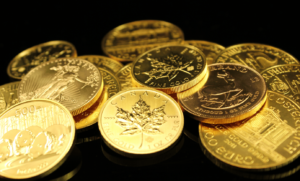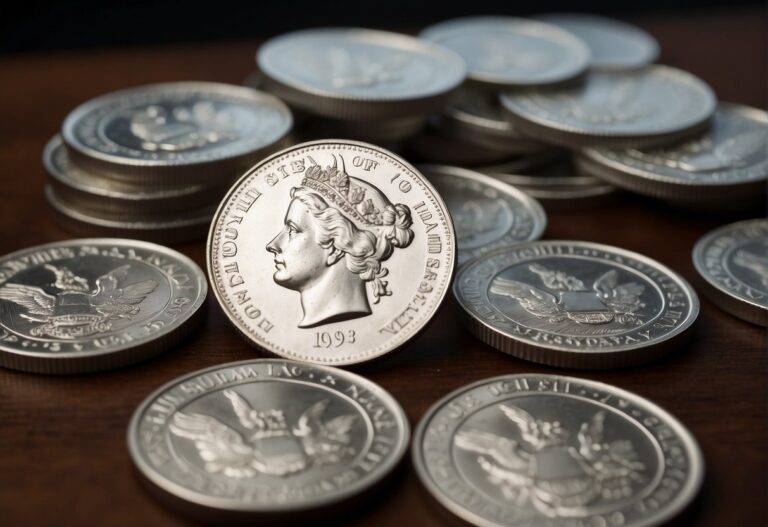Precious metals, with gold IRA at the forefront, have long been seen as a bastion of stability during economic downturns and a guard against inflation’s eroding effects.
Individuals considering including gold in their investment portfolios must understand the various avenues for such investments.
One such avenue is the gold Individual Retirement Account (IRA). A gold IRA presents a unique set of benefits and limitations that should be closely evaluated against an individual’s financial goals and circumstances.
Investors are tasked with navigating these considerations to ascertain whether a gold IRA aligns with their long-term financial strategy, aiming to provide a comprehensive resource for those contemplating this investment.
Understanding Gold IRAs
A Gold Individual Retirement Account (IRA) is a specialized Individual Retirement Account (IRA) that includes gold and other non-traditional investment assets, such as real estate and cryptocurrencies.
This form of account must comply with Internal Revenue Service (IRS) rules.
Unlike Traditional or Roth IRAs that typically contain stocks and bonds, a self-directed IRA offers a tax-advantaged space for diversifying with tangible assets.
Understanding Precious Metals IRAs
Eligible Precious Metals for Gold IRAs
Investors can include a variety of tangible assets in a Gold IRA beyond just gold. This investment method allows for the inclusion of silver, platinum, and palladium, expanding the options for diversification.
Each metal held within a Gold IRA must meet specific purity standards mandated by the IRS. Gold must be 99.5% pure, while silver should be 99.9% pure. Platinum and palladium must be 99.95% pure.
The IRS has specific regulations regarding acceptable forms and denominations, including bullion and certain coins, such as American Eagle proof and Canadian Maple Leaf coins.
These precious physical metals are stored securely, adhering to IRA regulations and ensuring safety and compliance.
By investing in physical gold and other precious metals within an IRA, individuals can enjoy tax advantages similar to traditional paper asset investments, like stocks or mutual funds. This includes comparable contribution limits and the same rules for required minimum distributions.
These IRAs provide a vehicle for hedging against inflation and diversifying investment portfolios with tangible assets.
Benefits of Investing in a Precious Metals IRA
Financial Advantages
Investing in a gold-backed IRA may offer significant fiscal perks akin to traditional retirement accounts.
Contributions made with pretax dollars can reduce an individual’s taxable earnings, and these investments typically incur no taxation until the investor withdraws funds from the account.
Asset Diversification
A gold IRA can strategically add to an investor’s asset mix, promoting a more balanced investment approach.
It is generally proposed that precious metals comprise a moderate portion of one’s retirement fund, such as 5-10%, to achieve diversification benefits.
Defense Against Inflation and Currency Depreciation
Gold has historically been regarded as a consistent store of value, often maintaining its worth irrespective of market fluctuations.
Its tendency to be inversely correlated with the stock market makes it a potential hedge during economic downturns and a safeguard against inflation and currency devaluation.
It’s crucial to acknowledge that, like any investment, gold’s value is not immune to decline.
Prospective Longevity in Retirement Wealth
Gold and other precious metals are valued for their inherent worth, providing an opportunity for enduring wealth accumulation in a retirement portfolio.
Those considering a gold IRA should be prepared for the natural price variations and have a long-term investment horizon to weather short-term market changes.
Disadvantages of Precious Metals IRAs
Increased Costs
Investing in a precious metals IRA can increase expenses than traditional retirement accounts.
Investors are often liable for management fees due to the more complex administration required by custodians managing these accounts. Furthermore, strict regulations demand the storage of physical gold in approved secure facilities, leading to additional storage and insurance costs.
Precious metals IRA providers also typically implement a spread, which increases the buying price compared to the selling price, effectively elevating the investment cost in this area.
Lower Growth Potential
Physical gold is a tangible asset; however, it does not experience the same appreciation potential over time as equities or mutual funds.
The lack of assured growth means that the value of gold might stay the same or decrease, impacting investors who plan to rely on their IRAs for retirement income.
This could lead to selling their holdings at a disadvantage, especially when required minimum distributions (RMDs) necessitate conversions into cash, which may involve additional expenses due to shipping and the need for secure storage post-distribution.
Absence of Earnings
In contrast to stocks or bonds that can produce dividends or interest, gold does not offer any form of passive income.
The compounding effect of income from traditional investments is a critical aspect of wealth accumulation over an investor’s lifetime, which is absent in gold holdings. This lack of income generation can be considered a missed opportunity in building a more substantial retirement fund.
Restricted Liquidity
Portfolio rebalancing is an essential strategy for investors to manage their asset allocation according to their financial goals and risk tolerance.
Yet, investors might need help to adjust their investment positions within a precious metals IRA.
Unlike stocks or exchange-traded funds (ETFs), which can be traded relatively quickly on financial markets, often with no commission, buying and selling gold can be less fluid and typically involves higher fees.
This can pose challenges for those who wish to frequently adjust their retirement portfolios in response to market volatility or personal circumstances.
Key Points When Investing in Precious Metals Retirement Accounts
Objectives for Retirement Investments
Those contemplating a precious metals Individual Retirement Account (IRA) should seek counsel from a dependable financial advisor who acts as a fiduciary.
This obligates them to prioritize the individual’s financial welfare instead of companies specializing in these IRAs, which may be biased due to their sales interests.
Choosing the Right Trustee and Bullion Provider
Investors can select the trustee and the depository institution for their precious metal IRA, though some firms steer clients toward their affiliates.
It’s critical to select firms that provide fair, transparent pricing and buyback options without additional fees.
Establishing a partnership with a company with a strong track record in unbiased client education and exemplary customer service can be more reassuring than succumbing to high-pressure sales techniques.
Understanding and Managing Investment Risks
Diversification is crucial in retirement portfolios, and while it’s possible to convert an entire traditional retirement account into a gold IRA, it could introduce significant risk.
A conventional retirement account offers a mix of assets, diversification, potential income generation, and liquidity essential for portfolio rebalancing.
Determining the Investment Size
Transferring funds from retirement accounts like 401(k)s, 403(b)s, 457 plans, pensions, or Thrift Savings Plan accounts into a precious metals IRA without inciting tax consequences if appropriately executed.
Weighing retirement income requirements, investment horizons, and risk tolerance will guide the proportion of assets to allocate to a gold IRA.
Reviewing Tax Consequences
Gold IRAs have distinct tax treatments similar to other tax-advantaged retirement accounts:
- IRA Tax Treatment
Gold IRAs, akin to traditional IRAs, use pre-tax dollars from accounts such as a 401(k). These contributions are tax-deferred until retirement withdrawals commence. - Roth IRA Tax Treatment
Conversely, a Roth IRA uses after-tax contributions, allowing for tax-free growth and untaxed distributions during retirement.
Assessing anticipated retirement income can indicate whether a traditional or Roth IRA may be more tax-efficient.
Establishing a Gold IRA
Selecting a Precious Metals Provider
When establishing a Gold Individual Retirement Account (IRA), one must first identify a reputable precious metals provider.
These providers play a crucial role by supplying the gold and performing the sale. Additionally, they facilitate the establishment of the IRA by partnering with a custodian to manage the account and an IRS-approved depository to store the purchased metals safely.
Initiating the Gold IRA
After selecting a provider, the process of initiating the Gold IRA begins.
The provider will assist in creating the necessary account and advise on the most appropriate method of transferring funds into this new investment vehicle. They often suggest a direct transfer between financial institutions to adhere to IRS guidelines and avoid potential penalties.
Deciding on Gold and Other Metals
Finally, the provider helps you make an informed decision about which IRS-eligible precious metals to include in the Gold IRA.
Options typically include gold bars or rounds and a variety of gold and silver coinage. Some providers may also offer the opportunity to invest in other permissible precious metals, such as platinum and palladium.
| Metal Type | Investment Forms |
|---|---|
| Gold | Bars, Rounds, Coins |
| Silver | Coins |
| Platinum | Available through select providers |
| Palladium | Available through select providers |
Frequently Asked Questions about Precious Metals IRA Accounts
Is Gold a Good Investment Choice
Gold is valued for its enduring appeal and role as a protective asset during economic uncertainty or inflation.
While suitable for some, it is only optimal for some; investing in gold should align with an individual’s financial goals, investment timeline, and risk appetite. It offers both pros and cons as an investment medium.
Understanding Gold Within Retirement Accounts
Retirement accounts may include specific gold coins and bars that meet the IRS’s requirements.
The U.S. Mint and other recognized mints produce these approved precious metal items. However, regulations mandate that such assets cannot be stored personally and must exclude collectibles.
Alternatives to Holding Physical Gold
Other investment avenues are available for those seeking exposure to precious metals without maintaining a physical collection. These include gold Exchange-Traded Funds (ETFs), mutual funds focused on gold, and equities within gold mining companies.
Standard brokerage accounts can facilitate these investments; some may be compatible with standard retirement accounts, such as 401(k) plans.




